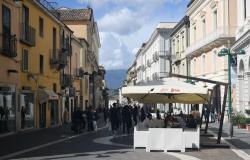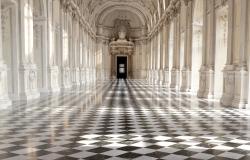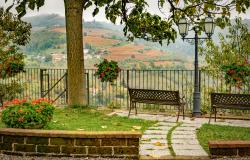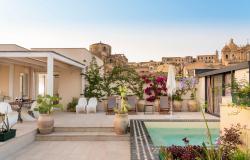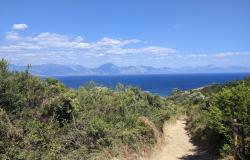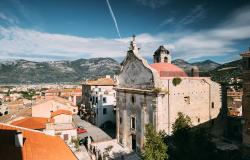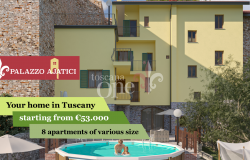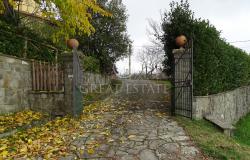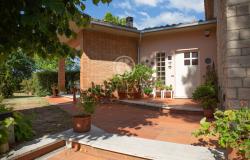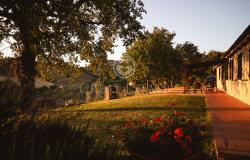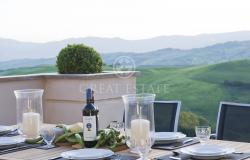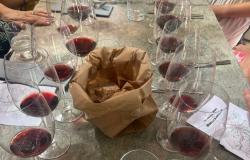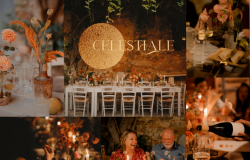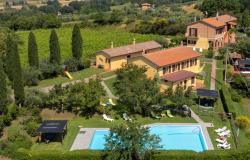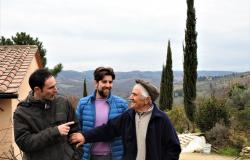The islands of Sicily and Sardinia are popular destinations for British and American tourists but there is a smaller, quieter island which is also well worth a visit.
Here are five things to do on “Napoleon’s island” of Elba:
1. Visit the two Napoleonic Residences.
Napoleon Bonaparte arrived on Elba as an exile on 4th May 1814. He escaped to France on 26th February 1815.
The Villa dei Mulini  When Napoleon was first brought to this house, it really consisted of two, one-storey small houses which were joined together. The land had formerly been home to two windmills, hence the name. Napoleon added a second storey and converted the barn into a ballroom. He liked the fresh air of this location and its commanding position above the island’s capital, Portoferraio. After his return to Paris for the Hundred Days, Napoleon gave the villa to the city of Portoferraio as a museum.
When Napoleon was first brought to this house, it really consisted of two, one-storey small houses which were joined together. The land had formerly been home to two windmills, hence the name. Napoleon added a second storey and converted the barn into a ballroom. He liked the fresh air of this location and its commanding position above the island’s capital, Portoferraio. After his return to Paris for the Hundred Days, Napoleon gave the villa to the city of Portoferraio as a museum.
During his time at the Villa, Napoleon used the ground floor, whilst the first floor was intended to house the apartments of his wife, Marie-Louise, and son but they never joined him on Elba.
You may find the Villa a rather melancholy place for certainly a tinge of sadness lingers there. In the 1950s the Elban authorities restored the furniture and acquired other pieces from the Napoleonic period. The Villa has undergone a more recent restoration and visitors can see Napoleon’s grand salon, study, and dressing room with the Elban flag depicted on one wall. There is also a sword worn by the Emperor. Napoleon’s bedroom contains the original furniture and the library still has his collection of books.
The Villa San Martino The Villa San Martino is Napoleon’s second residence on Elba, one which he found himself whilst out walking one day. His sister, Paolina Borghese, helped him to purchase it. Napoleon bought it as a “barn” and immediately organised a team to convert it into a villa.
The Villa San Martino is Napoleon’s second residence on Elba, one which he found himself whilst out walking one day. His sister, Paolina Borghese, helped him to purchase it. Napoleon bought it as a “barn” and immediately organised a team to convert it into a villa.
Set on a hillside, the Villa affords stunning views of the surrounding countryside and the sea.
Inside, visitors can see Napoleon’s reception room, bedroom, study and council chamber. [It is important to remember that he actually ruled the island.] In the nearby museum, built by Prince Anatole Demidoff and known to locals as “yellow granite” because it is ugly, Canova’s famous statue of Paolina can be seen.
This is a happier place than the Villa dei Mulini and one likes to imagine that the “little Emperor” enjoyed some of his time there.
Both villas can be reached from Portoferraio. For further information please call:
0039 065 915846
2. Visit some wonderful beaches
 Elba has over 70 clean, beautiful beaches such as Le Viste, near the Villa dei Mulini and Zuccale, near Capoliveri. This beach has clear, sparkling water and Mediterranean vegetation. There are pebble beaches at Calanova and Norsi and, if you are romantic, you will want to visit the Innamorata [“Girl in Love”] beach [also near Capoliveri]. This beach derives its name from a tragic event, which, according to legend, happened in 1534: Maria had gone to meet her lover, Lorenzo, on the beach and arrived just in time to see him being thrown from a ship by the pirates who had captured him. Poor Maria threw herself into the sea after him and the locals named their beach for her. This sad event is commemorated every year on 14th July.
Elba has over 70 clean, beautiful beaches such as Le Viste, near the Villa dei Mulini and Zuccale, near Capoliveri. This beach has clear, sparkling water and Mediterranean vegetation. There are pebble beaches at Calanova and Norsi and, if you are romantic, you will want to visit the Innamorata [“Girl in Love”] beach [also near Capoliveri]. This beach derives its name from a tragic event, which, according to legend, happened in 1534: Maria had gone to meet her lover, Lorenzo, on the beach and arrived just in time to see him being thrown from a ship by the pirates who had captured him. Poor Maria threw herself into the sea after him and the locals named their beach for her. This sad event is commemorated every year on 14th July.
3. Visit an iron mine
 Like all the islands of the Tuscan Archipelago, Elba is rich in mineral deposits. It was the Etruscans who began mining for minerals on Elba and mining continued until the 1980s. Now a Mining Park with a Mineral Museum has been created so that visitors can learn about this heritage. The Parco Minerario dell’Isola D’Elba has a little train which will take you around it with guides. There are various itineraries on offer, including a visit to the Bacino Iron Mine. For further information please see the Mining Park website.
Like all the islands of the Tuscan Archipelago, Elba is rich in mineral deposits. It was the Etruscans who began mining for minerals on Elba and mining continued until the 1980s. Now a Mining Park with a Mineral Museum has been created so that visitors can learn about this heritage. The Parco Minerario dell’Isola D’Elba has a little train which will take you around it with guides. There are various itineraries on offer, including a visit to the Bacino Iron Mine. For further information please see the Mining Park website.
4. Try limoncino, Elban wine and cacciucco.
 Every lemon-growing area of Italy has its own version of limoncello liqueur and this is the Elban one. The island has a long history of viticulture and is mentioned in this context by Pliny the Elder. The Elba red, Elba Aleatico Passito, received the DOCG classification this year.
Every lemon-growing area of Italy has its own version of limoncello liqueur and this is the Elban one. The island has a long history of viticulture and is mentioned in this context by Pliny the Elder. The Elba red, Elba Aleatico Passito, received the DOCG classification this year.
Elban food is, of course, Tuscan but the island does have its own versions of these dishes. In particular, you should try Elban cacciucco, a fish stew.
5. Christmas Market at Sant’Ilaria
Finally, if you are going to be in Elba this December, there is a Christmas Market at Sant’Ilario, the Mercatini di Sant’Ilario.
These are just a few things you can do on Elba island.

